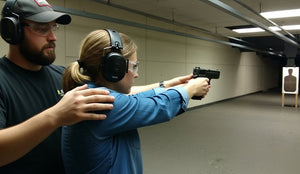The future is already here. It’s 2025, and red dots are everywhere. They’re affordable, boost accuracy, and look sharp on just about any pistol. So why even talk about iron sights?
Well, most handguns still ship from the factory with stock iron sights, and many of them are surprisingly good. Plus, you’ve got excellent upgrade options like fiber optic sights or tritium sights that can make a big difference in performance.
Some shooters might call them old-school, but iron sights remain the go-to aiming method when everything else fails. Even pros who swear by their optics will tell you: master your sight alignment and sight picture with irons. It’s a skill you can’t skip.
In this guide, we’ll break down the iron sights vs. red dot comparison. Because whether you’re running stock, fiber optic, or tritium, the right iron sights can sharpen your accuracy and improve your shooting experience. It all comes down to knowing what you need, and how to use it.
What are Iron Sights & Why is it Important?
Iron sights are one of the most reliable aiming devices ever made; the first of their kind, actually. On pistols, they work as a pair: the rear sight, usually at the back of the slide, and the front sight, mounted near the muzzle.
They run on a simple principle: align the front sight so it’s centered in the rear sight notch, with the tops of both sights level. This gives you proper pistol sight alignment and a clear sight picture, so your shot lands exactly where you want it.
But hold up, cowboy. We said the principle is simple, not easy.
In reality, shooting accurately with iron sights takes time, consistency, and training. Even small mistakes in alignment, grip, or stance can throw your shot off target. Iron sights or red dots won’t magically make you a better shooter, but they are tools that can improve your accuracy and target acquisition speed when used correctly.
Iron sights have a huge advantage: they don’t rely on batteries, are incredibly durable, and can be upgraded with fiber optic sights or tritium inserts for better visibility in any light.
Of course, this comes with some trade-offs against modern optics—which we’ll get into later. But first, let’s check out the main types of iron sights available for your pistol.
Types of Iron Sights
-
Fixed Iron Sights: The most basic and durable option, found on many duty and defensive pistols. They’re rugged, low-maintenance, and always ready.
-
Adjustable Iron Sights: Similar in design to fixed sights but with the ability to fine-tune—mainly the rear sight—for vertical and horizontal adjustments. These are common on competition pistols or as an upgrade for precision shooters.
-
Fiber Optic Sights: Bright green or red rods that capture light and make aiming faster in daylight or well-lit conditions. A favorite for quick sight picture acquisition.
-
Tritium Sights: Also called night iron sights, these glow in the dark thanks to tritium inserts, giving you a visible aiming point in low-light or no-light situations.
-
Suppressor-Height Sights: Taller irons designed to clear barrel extensions or serve as a co-witness with red dots and reflex optics. Perfect for suppressed pistols or optics-ready setups.
Target Sights Vs Combat Sights
Let’s get a little more specific and talk about two popular types of iron sights: target sights and combat sights. In short:
-
Target sights = narrow rear notch + thin front sight → precision first.
-
Combat sights = wide rear notch + larger front sight → speed first.
Let’s explain this better:
Target Sights
Target Sights feature a narrower rear notch paired with a thinner front sight, designed for maximum precision, even at longer distances. That’s why they’re a favorite among competitive shooters.
Target sights allow for extremely precise pistol sight alignment, producing tight groupings once you’ve mastered them. They can take a bit more time to line up quickly, but the payoff in accuracy is worth it.
Combat Sights
Combat sights are built for speed, with a wider rear notch and/or a larger front sight. This makes it easier to pick up your sight picture quickly, which is crucial in defensive or tactical scenarios.
The trade-off? For maximum precision, you still need to center that front sight perfectly within the rear notch.
How to Align Your Front and Rear Sight for Better Accuracy

Good sight alignment means your front and rear sights are perfectly positioned so the shot lands exactly where you want. Sounds simple on paper, but in practice, adjusting iron sights is where many shooters trip up.
Rear sight adjustments are the most common, and the easiest to work with:
-
Elevation (up/down): Raise the rear sight to make shots go higher. Lower it to make shots go lower.
-
Windage (left/right): Move the rear sight in the direction you want your shots to move.
That’s why most shooters focus on the rear sight: it’s more intuitive.
Front sight adjustments are trickier. On most handguns, the front sight is fixed, but if you upgrade or replace it, this is what you need to know:
-
Lowering the front sight will make your shots go higher.
-
Raising the front sight will make your shots go lower.
Since front sight adjustments work in the opposite direction, it’s easy to get turned around.
Once your sights are dialed in, you should be good to go. Achieving proper pistol sight alignment means having the front sight centered in the rear notch, with the tops level. From there, a clear sight picture means you can get your aligned sights placed on target, so your rounds should land where you expect.
We say should because hitting your mark requires more than just sight alignment. You'll need to master your grip, trigger pull, and stance all play a huge role. If you want to take your aim to the next level, check out our guides on shooting more accurately and improving trigger discipline.
But, with all the new tech and optics, is adjusting your sights even worth it? Let’s get into the big debate: iron sights vs. red dots.
Iron Sights vs. Red Dot – Which One is Better?
Everything in the gun world has pros and cons. Iron sights are always there when you need them. Red dots can give you a serious boost in accuracy. It’s just the way it is.
We’ve already covered iron sights—durable, reliable, and with upgrade options like fiber optic sights or tritium sights to improve accuracy and target acquisition speed. Still, the data is clear: most shooters who switch from irons to red dots see about a 20% improvement in accuracy.
Why red dots can improve accuracy? A red dot gives you a larger visual window. It’s faster to spot the dot on your target than it is to line up front and rear iron sights. Once you learn the golden rule—focus on the target, not the dot—your shooting speed and precision can jump significantly.
But red dots aren’t perfect. At first, they can feel awkward—like there’s an extra object in your sight picture where you expect to see your irons. They’re also more delicate and require batteries (but hey, most last a year or more).
Also, red dots add one more thing to check before shooting. Unlike irons, if the battery dies or the optic fails, your aiming method is gone. That is, unless you’ve got backup iron sights.
Let’s talk about the hidden benefits of the red dots: They are excellent training tools. Even when practicing dry fire drills, they make tiny hand movements visible, showing how steady (or shaky) your hold is. If your dot jumps up and to the side after each shot, your grip needs work. If it dips before the shot breaks, you’re flinching.
When & Why Should You Upgrade Your Iron Sight?
If you’re just starting out, a red dot can feel like a shortcut to accuracy. And while there’s some truth to that, it’s important not to skip iron sights practice. Mastering your sight alignment and sight picture with irons will make you a better shooter,no matter what optics you run later.
For self-defense and open carry, combat iron sights with tritium inserts are a rock-solid choice. They offer fast target acquisition even in low light, so you’re ready for anything.
Just think about this: most self-defense encounters happen within about 20 feet. At that range, and under high stress, you’re more likely to point-shoot than take time for a perfect sight picture.
That’s why red dots don’t offer much of an advantage for self-defense. Plus, for everyday carry, they can add bulk and make concealment harder.
Competition shooting is a different story. Target sights with fiber optic fronts provide a crisp sight picture in bright light, helping top shooters keep their hits in the A-zone. But in modern matches, you’ll see plenty of red dots—and that tech can give you an edge, especially in speed stages.
If you’re shooting Open Division or running high-speed courses, a good red dot optic can combine speed and precision for a real advantage. Just make sure your pistol is optics-ready. For co-witness setups, you’ll need suppressor-height sights.
You’ll often see this combo on pistols like the Canik SFx Rival—and when paired with a 45 Blast competition compensator, you can cut recoil by up to 60%, giving you better control and faster follow-up shots.
Bottom line: It’s not about iron sights versus red dots—it’s about choosing the right tool for your purpose. Defensive shooting? Irons are hard to beat for reliability. Precision competition? A red dot might give you the edge.
How To Improve Your Aim With Iron Sights or Red Dots
So, if you’re dedicated to irons, try the red dot challenge—you might be surprised. If your aim is already dialed in, switching to a dot can reveal subtle improvements in your groupings and highlight areas to fine-tune.
And if you’re a hard believer in red dots, we encourage you to every once in a while take on challenges with iron sights. If you prefer, make them even cooler and more effective with fiber optics or tritium upgrades. That way, your confidence doesn’t rely solely on your red dot.
The best part about the iron sights vs. red dot debate? The real answer lives on the range. And here’s the even better news: no matter what optics you’re running, you can boost your speed, accuracy, and overall performance with one of our premium compensators.
The right gear does more than help you shoot better—it inspires you to take your skills to the next level. That’s exactly what we’re about at 45 Blast. Gear up, hit the range, and let’s make every shot count.


